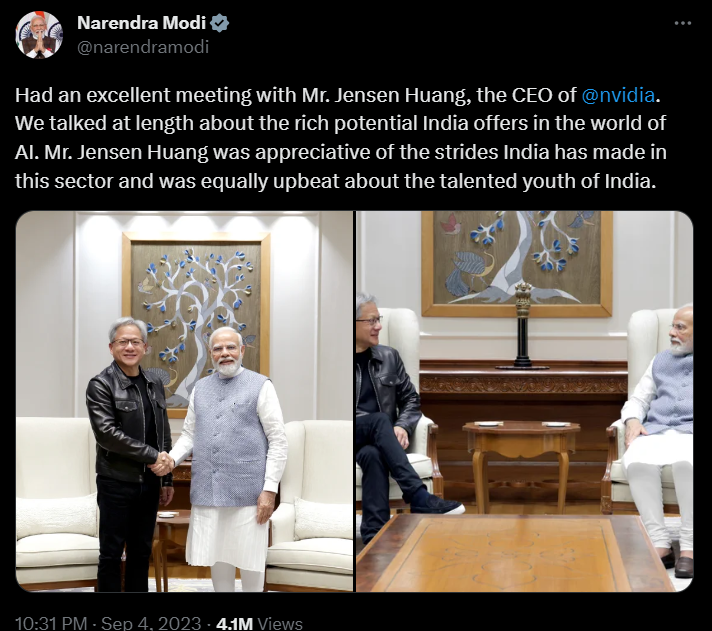Nvidia sets its eye on India as a significant AI market

- Nvidia believes India ought to be one of the largest AI markets in the world.
- India’s large population and growing tech industry could provide Nvidia with new opportunities.
- India still has some growing to do before it can become a mature AI hub.
India has often been recognized as a global center for technology and innovation and, more recently, as an alternative to China for Western countries trying to stay on the right side of the US. Its amicable relations with Western countries and its young workforce have made it an attractive destination for foreign companies seeking to reduce their reliance on China. This appeal has led to India successfully attracting major tech companies since the pandemic. Now, Nvidia Corp is eager to join this trend.
India’s rapid technological progress, infrastructure development, and efforts to enhance domestic manufacturing capabilities have positioned the country on a prominent global stage. While China excels in manufacturing and infrastructure and India in services and information technology, the latter’s manufacturing sector has expanded and become internationally competitive.
India is also gradually gaining attention as a possible global hub for artificial intelligence (AI) — the one trend that has kept the technology world buzzing since the beginning of 2023. India’s flourishing talents make it an ideal place for AI to flourish. Nasscom’s State of Data Science and AI Skills report highlighted that India is home to 16% of the world’s AI talent pool and one of the largest annual STEM supply lines, with 2.25 million graduates.
In short, India has the second largest AI/machine learning (ML)/big data analytics talent pool globally — second only to China. “You have the data, you have the talent,” said Jensen Huang, Nvidia’s CEO, at a news conference in Bangalore. Huang was on a five-day tour of India, meeting the country’s premier, researchers, and tech leaders.
During the news conference, Huang emphasized that India “is going to be one of the largest AI markets in the world.” As Bloomberg puts it, for Nvidia, whose graphics processors are vital to developing AI systems, India and its 1.4 billion people present a rare opportunity.

The meeting between the Prime Minister of India and the CEO of Nvidia. Source: Narendra Modi’s Twitter.
“As the US increasingly clamps down on exports of high-end chips to China and the world seeks an alternative electronics manufacturing base, India could shape up to be a source of AI talent, site for chip production, and market for Nvidia’s products,” the report reads. Huang even spoke of re-training entire swathes of the country’s workforce and building future AI models using Indian data and talent, according to multiple attendees following his meeting with leading researchers in Delhi.
Currently, Nvidia has four engineering centers in India, including sites in Bangalore and the Gurgaon suburbs of Delhi, with a total of 4,000 engineers, its second-biggest talent pool after the US. During his trip, Huang held town halls at each location and stressed the importance of remaining competitive in a rapidly evolving AI marketplace.
There is a shared interest for both Nvidia and India: to speed up India’s AI ascendancy. “India is the only market remaining, so it isn’t surprising that Nvidia wants to put multiple eggs in that basket,” Neil Shah, vice president of research at Counterpoint Technology Market Research, told Bloomberg.
Does it make sense for Nvidia to set up a base in India?
Truthfully, India is still far from developing the cutting-edge capabilities needed to manufacture Nvidia’s sophisticated chips. Although the country has had reasonable success in enticing tech giants like Apple Inc and Amazon.com Inc. to shift contract electronics manufacturing from China, the country needs more to boost its electronics manufacturing sector.
In fact, the South Asian nation has been focusing on semiconductors, “armed with some experience in chip design and no history whatsoever in semiconductor foundries,” Bloomberg noted. In the past several decades alone, the country spent billions to reach its current levels of manufacturing sophistication.
However, India has a more ambitious goal to boost electronics manufacturing and harness AI to buoy its digital economy. The country has been plowing billions into subsidies for chip manufacturing infrastructure to lure chip giants. Regarding AI specifically, there are challenges in turning India into an AI hub.
For a start, India currently has no exascale compute capacity — being able to handle a billion billion calculations per second — nor the ready AI talent capable of writing sophisticated software, Sashikumaar Ganesan told Bloomberg. Ganesan chairs the computational and data sciences department at the Indian Institute of Science. “We have to build not just AI infrastructure but also a high-performance computing workforce,” Ganesan added.
Still, India has seen massive demand for Nvidia’s GPUs because the country is fast maturing for high-end technologies. Huang and Nvidia saw signs of that potential during the trip. Announced during Huang’s multi-city tour, India’s largest conglomerate, Reliance, said its Jio platforms would build AI computing infrastructure for the country. The AI cloud will use end-to-end Nvidia supercomputing technologies, the company said in a release.
“Nvidia and Reliance Industries announced a collaboration to develop India’s own foundation large language model trained on the nation’s diverse languages and tailored for generative AI applications to serve the world’s most populous nation,” the statement reads. Nvidia will provide access to its most advanced GH200 Grace Hopper superchip and DGX cloud, an AI supercomputing service in the cloud.
GH200 marks a fundamental shift in computing architecture that provides exceptional performance and massive memory bandwidth. Besides Reliance, Indian conglomerate Tata will also build and operate state-of-the-art AI supercomputing data centers and offer AI infrastructure for researchers, corporations, and startups, Nvidia said, without in this final instance giving details or sharing timelines.










